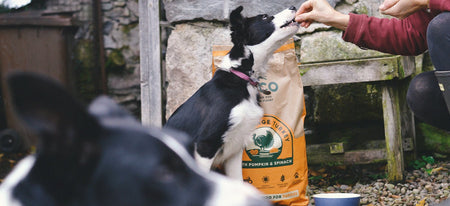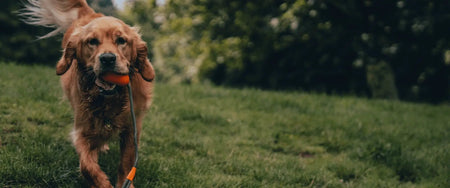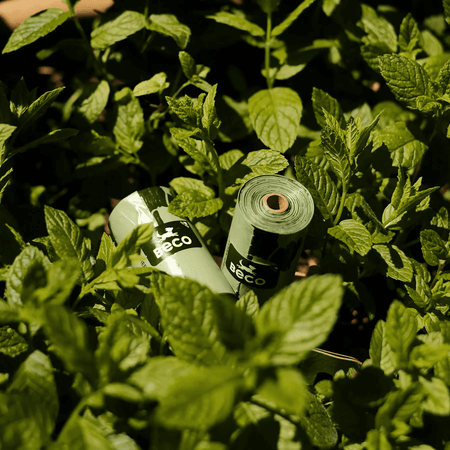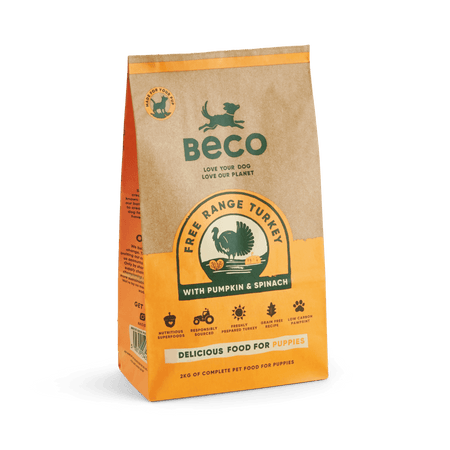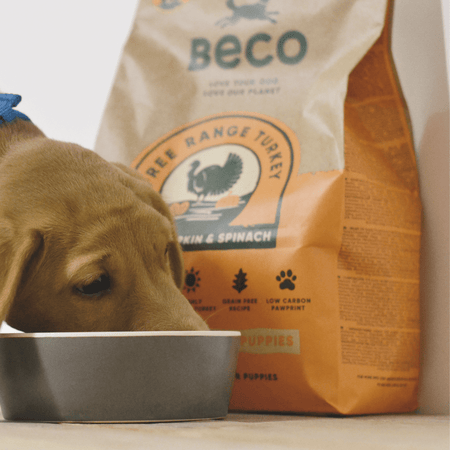There’s nothing quite like the early days of puppyhood. It’s the start of an unforgettable journey together, an adventure that lasts a lifetime. At the start, you teach them new tricks, watch their confidence grow and spend countless hours cuddling up to them on the sofa, and it’s these moments that make the sleepless nights all worthwhile.
It doesn’t take long for most puppies to start thinking with their stomachs, and we’re not just talking about our famously food-driven friends in the form of Labrador Retrievers, here. This inevitably raises the question of what you should be feeding your puppy, and at what point. More specifically, just when can puppies eat solid food? And how do you go about that transition from liquid food to dry?
What they eat at the beginning has a big say when it comes to the growth of their muscles, and the development of their teeth and bones. That’s why, when it comes to food, it’s important that your puppy has everything he/she needs to support them through their early development. It’s our job to make sure we get dinner time spot on.
What Age Can Puppies Eat Dry Food? – Key Takeaways
- Generally speaking, your puppy will be ready to eat dry food by 8 to 10 weeks old (at the end of the four-week weaning process, which starts when the puppy is 4 to 5 weeks old). However, this will vary from dog to dog.
- Once your puppy has moved onto dry food, it’s a good idea to feed them kibble that’s been formulated specifically for puppies; this will typically be higher in calories, protein and certain nutrients, than dry food aimed at fully-matured dogs.
What Should I Feed My Puppy?
When it comes to dry dog food, or any dog food or that matter, the issue is that a lot of dog owners do things differently. Some owners swear by purely wet dog food, while others fly the flag for dry food. Ultimately, this causes a lot of confusion. People start to ask questions: what’s the best puppy food? Or, when can a puppy eat adult food? The major question that owners want to know, however, is this – when can puppies start eating dry dog food.
We’ve put together a step-by-step guide to feeding puppies; what they should be eating at the start, how you help them get used to solid foods and when they can start to eat dry food. This is a guide to help all puppy owners give their pups the best start in life – if you’re stuck on what to feed yours, be sure to give it a read.
The Importance of Weaning
Weaning takes place when your puppy is 4 to 5 weeks old. It is the gradual transition from milk to solid food, a vital stage in their development. When puppies are born, they rely solely on their mother’s milk. If a puppy stays on milk for too long, the transition will become increasingly challenging. As for the mother, they need their own rest and a break from the kids.
The weaning process takes roughly 4 weeks, so owners must be patient. Puppies need a mushy texture. So, make sure you keep an eye on what they’re munching on, both during and outside of dinner time. After 4 weeks of weaning, your pup should have developed their full set of teeth (8 to 10 weeks old).
How Do You Get this Mushy Consistency?
Well, it’s a combination of dry dog food and liquid. We suggest letting the liquid soak into the kibble, then, mash it with a spoon to get the ideal consistency – our bamboo sporks do just the trick.
The amount of water to dry food ratio changes week-to-week. But we’ve outlined the exact measurements you need for the 4-week weaning stage. And if that’s not enough, we’ve included our very own Beco feeding guide, for puppies of all shapes and sizes.
4-Week Weaning Guide – When Can Puppies Eat Dry Food Without Water?
- Week 1: one part dry dog food, three parts liquid.
- Week 2: two parts dry dog food, two parts liquid.
- Week 3: three parts dry dog food, one part liquid.
- Week 4: your pup should be ready to eat dry dog food.
Can 6-Week Old Puppies Eat Dry Food?
As outlined in the weaning guide above, by about 6 weeks old your puppy will be in the first or second week of weaning; that means that dry food will still only comprise a relatively small part of your dog’s diet.
A puppy’s tummy can be temperamental. Remember, puppies are a lot smaller than normal dogs – despite their appetite suggesting otherwise! Where you’d feed a regular-sized dog substantial meals maybe once or twice a day, we recommend feeding puppies smaller but more frequent meals – three to four times a day. It’s also always a safe bet to look for sensitive stomach puppy food.
If your puppy seems to be struggling with the transition from liquid to dry food, we advise slowing down the weaning process. No puppy is the same, so don’t worry if yours is taking a little longer than expected.
What Can I Feed My Puppy When they’re Able to Eat Dry Food?

So, your puppy has made it to a point where they’ve developed a strong set of baby teeth, and can now start munching away at whatever they fancy – as long as it’s not the curtains.
After a few months, you’re likely to be an expert in mushing kibble and liquid – a master of measurements, an eagle eye at feeding time.
Like we said, it’s a process. But just because your puppy now has teeth, it doesn’t mean you can let them indulge in whatever they want. There’s still plenty of development to be done, so you need to make sure they’re eating healthy puppy food, with:
- High calories: puppies need a lot of energy, because they have so much growing to do. This is why most puppy foods will be higher in calories than most adult alternatives.
- Extra protein: puppies need lots of protein to help their muscles and organs develop.
- Lots of nutrients: your pup needs all of the essentials, like calcium, magnesium, iron, zinc and the all-important Vitamin D.
- Glucosamine: the miracle ingredient that supports the development of teeth and bones.
- Digestible ingredients: foods that are easily absorbed, so they get every drop of nutritious goodness.
How Much Dry Food Should I Feed My Puppy?
This will vary depending on the type of food you are feeding your pup. However, this feeding guide is based on nutrient-rich dry puppy food like our own. If you’re unsure about the food, though, and there are no clear instructions on the packaging, then give your vet a call to ask for their advice.
| Puppy wt. | 1-2 mos. | 2-4 mos. | 4-6 mos. | 6-8 mos. |
|---|---|---|---|---|
| 0.5kg | 25g | 50g | 55g | 50g |
| 1kg | 35g | 70g | 65g | 60g |
| 2kg | 55g | 90g | 80g | 80g |
| 3kg | 75g | 100g | 100g | 100g |
| 4kg | 85g | 110g | 110g | 110g |
| 5kg | 95g | 120g | 135g | 135g |
| 6kg | 105g | 140g | 145g | 145g |
| 7kg | 125g | 150g | 165g | 150g |
| 8kg | 135g | 160g | 175g | 160g |
Final Thoughts
So, you now know the step-by-step guide to feeding your puppy. From weaning through to baby teeth, it’s now time for you to start feeding, good luck! But what’s on the menu? Well, we would suggest our grain free puppy food. It has all of the nutrients needed to get your puppy up and running, and it’s a great choice for owners looking for the best dry puppy food. If you’re only just starting out, we also suggest looking at our puppy pack, which provides some of the key essentials to kicking off your journey with your pup in the right way!


